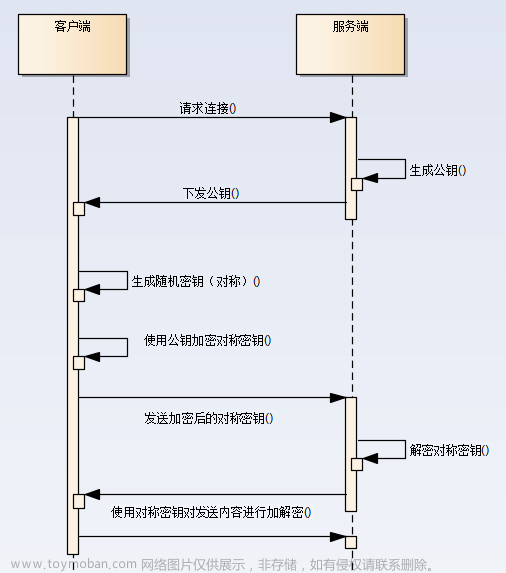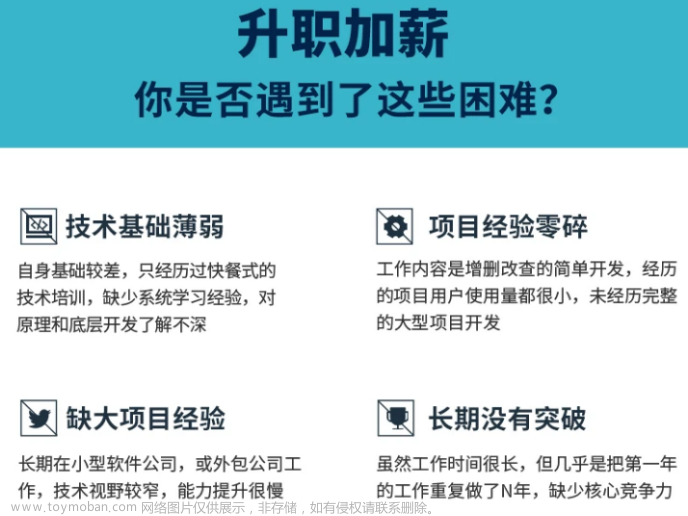说在前头,文本主要参考:
SpringBoot+WebSocket+Netty实现消息推送
Netty-11-channelHandler的生命周期
springboot整合netty指北
首先需要了解下channel建立的生命周期
ChannelHandler的顺序如下:
handlerAdded() –> channelRegistered() –> channelActive() –> channelRead() –> channelReadComplete()
注意本次实现的重点是:在建立websocket时从请求标头header或者第一次消息对话时获取用户信息(如jwt的令牌等)来校验用户身份是关键
1.NettyConfig
定义一个管理所有的channel组单例
import io.netty.channel.Channel;
import io.netty.channel.group.ChannelGroup;
import io.netty.channel.group.DefaultChannelGroup;
import io.netty.util.concurrent.GlobalEventExecutor;
import java.util.concurrent.ConcurrentHashMap;
/**
* @author sixiaojie
* @date 2020-03-28-15:07
*/
public class NettyConfig {
/**
* 定义一个channel组,管理所有的channel
* GlobalEventExecutor.INSTANCE 是全局的事件执行器,是一个单例
*/
private static ChannelGroup channelGroup = new DefaultChannelGroup(GlobalEventExecutor.INSTANCE);
/**
* 存放用户与Chanel的对应信息,用于给指定用户发送消息
*/
private static ConcurrentHashMap<String,Channel> userChannelMap = new ConcurrentHashMap<>();
private NettyConfig() {}
/**
* 获取channel组
* @return
*/
public static ChannelGroup getChannelGroup() {
return channelGroup;
}
/**
* 获取用户channel map
* @return
*/
public static ConcurrentHashMap<String,Channel> getUserChannelMap(){
return userChannelMap;
}
}
2.ChannelInboundHandlerAdapter
继承Channel处理器并实现channelRead作为连接认证
众所周知 WebSocket不能自定义header,那怎么在header中加入token呢
查看js中websocket,发现
new WebSocket(url [protocols]);
websocket的子协议可以是一个数组,这个值无论在 HTTP 中也好、在 WebSocket 中也罢,都是前后端之间的“约定”,得两端都得遵守才行,那把用户认证信息放在数组中的第一个下标位置,后端就能正常拿到
曲线救国(不是
//这里用的飞书小程序
//websocket
let socket = tt.connectSocket({
url: "ws://localhost:58080/webSocket",
header:{},
protocols:[token],
success() {
console.log('Build WebSocketTask success');
},
fail(err) {
console.error('Build WebSocketTask failed', err);
}
});
import com.feishu.estate.netty.nettypush.config.NettyConfig;
import io.jsonwebtoken.Claims;
import io.netty.channel.Channel;
import io.netty.channel.ChannelHandler;
import io.netty.channel.ChannelHandlerContext;
import io.netty.channel.ChannelInboundHandlerAdapter;
import io.netty.handler.codec.http.FullHttpRequest;
import io.netty.handler.codec.http.HttpHeaders;
import io.netty.util.AttributeKey;
import lombok.RequiredArgsConstructor;
import lombok.extern.slf4j.Slf4j;
import org.springframework.beans.factory.annotation.Autowired;
import org.springframework.stereotype.Component;
/**
* FullHttpRequest
*/
@ChannelHandler.Sharable
@Slf4j
@Component
@RequiredArgsConstructor(onConstructor = @__(@Autowired))
public class AuthHandler extends ChannelInboundHandlerAdapter {
@Override
public void channelRead(ChannelHandlerContext ctx, Object msg) throws Exception {
if (msg instanceof FullHttpRequest) {
// 获取请求头中的身份验证令牌
FullHttpRequest request = (FullHttpRequest) msg;
HttpHeaders headers = request.headers();
if (headers.size() < 1) {
ctx.channel().close();
return;
}
String uid = headers.get("Sec-WebSocket-Protocol");
log.debug("Authentication success. uid: {}", uid);
// 将用户ID作为自定义属性加入到channel中,方便随时channel中获取用户ID
AttributeKey<String> key = AttributeKey.valueOf("userId");
ctx.channel().attr(key).setIfAbsent(uid);
// 关联channel
NettyConfig.getUserChannelMap().put(uid,ctx.channel());
ctx.pipeline().remove(this);
// 对事件进行传播,知道完成WebSocket连接。
ctx.fireChannelRead(msg);
} else {
ctx.channel().close();
}
}
@Override
public void exceptionCaught(ChannelHandlerContext ctx, Throwable cause) throws Exception {
cause.printStackTrace();
ctx.channel().close();
}
}
这里偷下懒,正常从header中拿到子协议之后,转成数组取第一个元素,可以自己做一些解析,如jwt令牌如下
/**
* 从令牌中获取数据声明
*
* @param token 令牌
* @return 数据声明
*/
private Claims parseToken(String token)
{
return Jwts.parser()
.setSigningKey(secret)
.parseClaimsJws(token)
.getBody();
}
3.SimpleChannelInboundHandler
用来处理文本帧的处理器
在这里重写了handlerAdded,参照本文开始的说明,会第一个执行,然后执行第2步的校验,在测试的过程中发现一些h5无法在建立websocket链接时无法传递子协议,那么可以放在第一次消息发送中channelRead0处理。
import cn.hutool.json.JSONObject;
import cn.hutool.json.JSONUtil;
import com.feishu.estate.netty.nettypush.config.NettyConfig;
import io.jsonwebtoken.Claims;
import io.jsonwebtoken.Jwts;
import io.netty.channel.ChannelHandler;
import io.netty.channel.ChannelHandlerContext;
import io.netty.channel.SimpleChannelInboundHandler;
import io.netty.handler.codec.http.HttpHeaders;
import io.netty.handler.codec.http.websocketx.TextWebSocketFrame;
import io.netty.util.AttributeKey;
import org.slf4j.Logger;
import org.slf4j.LoggerFactory;
import org.springframework.beans.factory.annotation.Value;
import org.springframework.stereotype.Component;
/**
* TextWebSocketFrame类型, 表示一个文本帧
* @author sixiaojie
* @date 2020-03-28-13:47
*/
@Component
@ChannelHandler.Sharable
public class WebSocketHandler extends SimpleChannelInboundHandler<TextWebSocketFrame> {
private static final Logger log = LoggerFactory.getLogger(NettyServer.class);
// 令牌秘钥
@Value("${token.secret}")
private String secret;
/**
* 一旦连接,第一个被执行
* @param ctx
* @throws Exception
*/
@Override
public void handlerAdded(ChannelHandlerContext ctx) throws Exception {
log.info("handlerAdded 被调用"+ctx.channel().id().asLongText());
// 添加到channelGroup 通道组
NettyConfig.getChannelGroup().add(ctx.channel());
}
/**
* 读取数据
*/
@Override
protected void channelRead0(ChannelHandlerContext ctx, TextWebSocketFrame msg) throws Exception {
log.info("服务器收到消息:{}",msg.text());
// // 获取用户ID
// JSONObject jsonObject = JSONUtil.parseObj(msg.text());
// String uid = jsonObject.getStr("uid");
//
// // 将用户ID作为自定义属性加入到channel中,方便随时channel中获取用户ID
// AttributeKey<String> key = AttributeKey.valueOf("userId");
// ctx.channel().attr(key).setIfAbsent(uid);
//
// // 关联channel
// NettyConfig.getUserChannelMap().put(uid,ctx.channel());
// 回复消息
ctx.channel().writeAndFlush(new TextWebSocketFrame("服务器连接成功!"));
}
@Override
public void handlerRemoved(ChannelHandlerContext ctx) throws Exception {
log.info("handlerRemoved 被调用"+ctx.channel().id().asLongText());
// 删除通道
NettyConfig.getChannelGroup().remove(ctx.channel());
removeUserId(ctx);
}
@Override
public void exceptionCaught(ChannelHandlerContext ctx, Throwable cause) throws Exception {
log.info("异常:{}",cause.getMessage());
// 删除通道
NettyConfig.getChannelGroup().remove(ctx.channel());
removeUserId(ctx);
ctx.close();
}
/**
* 删除用户与channel的对应关系
* @param ctx
*/
private void removeUserId(ChannelHandlerContext ctx){
AttributeKey<String> key = AttributeKey.valueOf("userId");
String userId = ctx.channel().attr(key).get();
NettyConfig.getUserChannelMap().remove(userId);
}
}
本地测试的前端代码
<!DOCTYPE html>
<html lang="en">
<head>
<meta charset="UTF-8">
<title>Title</title>
</head>
<body>
<script>
var socket;
// 判断当前浏览器是否支持webSocket
if(window.WebSocket){
socket = new WebSocket('ws://localhost:58080/webSocket','custome-protocol')
// 相当于channel的read事件,ev 收到服务器回送的消息
socket.onmessage = function (ev) {
var rt = document.getElementById("responseText");
rt.value = rt.value + "\n" + ev.data;
}
// 相当于连接开启
socket.onopen = function (ev) {
// 设置请求头
var rt = document.getElementById("responseText");
rt.value = "连接开启了..."
socket.send(
JSON.stringify({
// 连接成功将,用户ID传给服务端
uid: "123456"
})
);
}
// 相当于连接关闭
socket.onclose = function (ev) {
var rt = document.getElementById("responseText");
rt.value = rt.value + "\n" + "连接关闭了...";
}
socket.addEventListener('beforeSend', function(event) {
event.target.setRequestHeader('Authorization', 'Bearer ' + '1111');
event.target.setRequestHeader('Custom-Header', 'value');
});
}else{
alert("当前浏览器不支持webSocket")
}
</script>
<form onsubmit="return false">
<textarea id="responseText" style="height: 150px; width: 300px;"></textarea>
<input type="button" value="清空内容" onclick="document.getElementById('responseText').value=''">
</form>
</body>
</html>
4.加一个心跳处理
import io.netty.channel.ChannelHandlerContext;
import io.netty.channel.ChannelInboundHandlerAdapter;
import io.netty.handler.timeout.IdleState;
import io.netty.handler.timeout.IdleStateEvent;
/**
* 若连续2次无读事件,则关闭这个客户端channel
* @author sixiaojie
* @date 2020-08-21-16:14
*/
public class HeartBeatHandler extends ChannelInboundHandlerAdapter {
private int lossConnectCount = 0;
@Override
public void userEventTriggered(ChannelHandlerContext ctx, Object evt) throws Exception {
if (evt instanceof IdleStateEvent){
IdleStateEvent event = (IdleStateEvent)evt;
if (event.state()== IdleState.READER_IDLE){
lossConnectCount ++;
if (lossConnectCount > 2){
ctx.channel().close();
}
}
}else {
super.userEventTriggered(ctx,evt);
}
}
}
5.NettyServer实现WebSocket
将上面的自定义实现的处理器都丢进去
import io.netty.bootstrap.ServerBootstrap;
import io.netty.channel.ChannelFuture;
import io.netty.channel.ChannelInitializer;
import io.netty.channel.EventLoopGroup;
import io.netty.channel.nio.NioEventLoopGroup;
import io.netty.channel.socket.SocketChannel;
import io.netty.channel.socket.nio.NioServerSocketChannel;
import io.netty.handler.codec.http.HttpObjectAggregator;
import io.netty.handler.codec.http.HttpServerCodec;
import io.netty.handler.codec.http.websocketx.WebSocketServerProtocolHandler;
import io.netty.handler.codec.serialization.ObjectEncoder;
import io.netty.handler.stream.ChunkedWriteHandler;
import io.netty.handler.timeout.IdleStateHandler;
import org.slf4j.Logger;
import org.slf4j.LoggerFactory;
import org.springframework.beans.factory.annotation.Autowired;
import org.springframework.beans.factory.annotation.Value;
import org.springframework.stereotype.Component;
import javax.annotation.PostConstruct;
import javax.annotation.PreDestroy;
import java.net.InetSocketAddress;
/**
* @author sixiaojie
* @date 2020-03-28-13:44
*/
@Component
public class NettyServer{
private static final Logger log = LoggerFactory.getLogger(NettyServer.class);
/**
* webSocket协议名
*/
private static final String WEBSOCKET_PROTOCOL = "WebSocket";
/**
* 端口号
*/
@Value("${webSocket.netty.port:58080}")
private int port;
/**
* webSocket路径
*/
@Value("${webSocket.netty.path:/webSocket}")
private String webSocketPath;
@Autowired
private WebSocketHandler webSocketHandler;
@Autowired
private AuthHandler authHandler;
private EventLoopGroup bossGroup;
private EventLoopGroup workGroup;
/**
* 启动
* @throws InterruptedException
*/
private void start() throws InterruptedException {
bossGroup = new NioEventLoopGroup();
workGroup = new NioEventLoopGroup();
ServerBootstrap bootstrap = new ServerBootstrap();
// bossGroup辅助客户端的tcp连接请求, workGroup负责与客户端之前的读写操作
bootstrap.group(bossGroup,workGroup);
// 设置NIO类型的channel
bootstrap.channel(NioServerSocketChannel.class);
// 设置监听端口
bootstrap.localAddress(new InetSocketAddress(port));
// 连接到达时会创建一个通道
bootstrap.childHandler(new ChannelInitializer<SocketChannel>() {
@Override
protected void initChannel(SocketChannel ch) throws Exception {
// 流水线管理通道中的处理程序(Handler),用来处理业务
// webSocket协议本身是基于http协议的,所以这边也要使用http编解码器
ch.pipeline().addLast(new HttpServerCodec());
ch.pipeline().addLast(new ObjectEncoder());
// 以块的方式来写的处理器
ch.pipeline().addLast(new ChunkedWriteHandler());
/*
说明:
1、http数据在传输过程中是分段的,HttpObjectAggregator可以将多个段聚合
2、这就是为什么,当浏览器发送大量数据时,就会发送多次http请求
*/
ch.pipeline().addLast(new HttpObjectAggregator(8192));
// 自定义的handler,处理身份验证
ch.pipeline().addLast(authHandler);
//针对客户端,若10s内无读事件则触发心跳处理方法HeartBeatHandler#userEventTriggered
ch.pipeline().addLast(new IdleStateHandler(10 , 0 , 0));
//自定义空闲状态检测(自定义心跳检测handler)
ch.pipeline().addLast(new HeartBeatHandler());
/*
说明:
1、对应webSocket,它的数据是以帧(frame)的形式传递
2、浏览器请求时 ws://localhost:58080/xxx 表示请求的uri
3、核心功能是将http协议升级为ws协议,保持长连接
*/
ch.pipeline().addLast(new WebSocketServerProtocolHandler(webSocketPath, WEBSOCKET_PROTOCOL, true, 65536 * 10));
// 自定义的handler,处理业务逻辑
ch.pipeline().addLast(webSocketHandler);
}
});
// 配置完成,开始绑定server,通过调用sync同步方法阻塞直到绑定成功
ChannelFuture channelFuture = bootstrap.bind().sync();
log.info("Server started and listen on:{}",channelFuture.channel().localAddress());
// 对关闭通道进行监听
channelFuture.channel().closeFuture().sync();
}
/**
* 释放资源
* @throws InterruptedException
*/
@PreDestroy
public void destroy() throws InterruptedException {
if(bossGroup != null){
bossGroup.shutdownGracefully().sync();
}
if(workGroup != null){
workGroup.shutdownGracefully().sync();
}
}
@PostConstruct()
public void init() {
//需要开启一个新的线程来执行netty server 服务器
new Thread(() -> {
try {
start();
} catch (InterruptedException e) {
e.printStackTrace();
}
}).start();
}
}
6.把发送消息Service补上
本文没有实现分布式的情况下如何处理消息发送,需要的同学可以参考文章的第一个链接文章来源:https://www.toymoban.com/news/detail-762660.html
/**
* @author sixiaojie
* @date 2020-03-30-17:06
*/
public interface PushService {
/**
* 推送给指定用户
* @param userId
* @param msg
*/
void pushMsgToOne(String userId,String msg);
/**
* 推送给所有用户
* @param msg
*/
void pushMsgToAll(String msg);
}
import com.feishu.estate.netty.nettypush.config.NettyConfig;
import com.feishu.estate.netty.nettypush.constant.BaseConstant;
import com.feishu.estate.netty.nettypush.pubsub.NettyPushMessageBody;
import io.netty.channel.Channel;
import io.netty.handler.codec.http.websocketx.TextWebSocketFrame;
import org.springframework.beans.factory.annotation.Autowired;
import org.springframework.data.redis.core.RedisTemplate;
import org.springframework.stereotype.Service;
import java.util.Objects;
import java.util.concurrent.ConcurrentHashMap;
/**
* @author sixiaojie
* @date 2020-03-30-20:10
*/
@Service
public class PushServiceImpl implements PushService {
// @Autowired
// private RedisTemplate redisTemplate;
@Override
public void pushMsgToOne(String userId, String msg){
ConcurrentHashMap<String, Channel> userChannelMap = NettyConfig.getUserChannelMap();
Channel channel = userChannelMap.get(userId);
if(!Objects.isNull(channel)){
// 如果该用户的客户端是与本服务器建立的channel,直接推送消息
channel.writeAndFlush(new TextWebSocketFrame(msg));
}else {
// 发布,给其他服务器消费
// NettyPushMessageBody pushMessageBody = new NettyPushMessageBody();
// pushMessageBody.setUserId(userId);
// pushMessageBody.setMessage(msg);
// redisTemplate.convertAndSend(BaseConstant.PUSH_MESSAGE_TO_ONE,pushMessageBody);
}
}
@Override
public void pushMsgToAll(String msg){
// 发布,给其他服务器消费
// redisTemplate.convertAndSend(BaseConstant.PUSH_MESSAGE_TO_ALL,msg);
NettyConfig.getChannelGroup().writeAndFlush(new TextWebSocketFrame(msg));
}
}
ok,到此就大概完成了用netty搭建websocket文章来源地址https://www.toymoban.com/news/detail-762660.html
到了这里,关于基于Springboot用Netty实现WebSocket及用户身份校验的文章就介绍完了。如果您还想了解更多内容,请在右上角搜索TOY模板网以前的文章或继续浏览下面的相关文章,希望大家以后多多支持TOY模板网!











